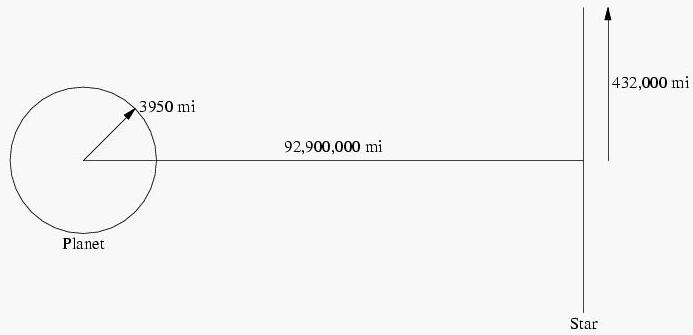当前你的浏览器版本过低,网站已在兼容模式下运行,兼容模式仅提供最小功能支持,网站样式可能显示不正常。
请尽快升级浏览器以体验网站在线编辑、在线运行等功能。
1494:Sunrise
Special Judge 特殊评判题目描述
Compute the fraction of the solar-disc area that is visible at specified times after the onset of sunrise.
This is a two-body problem; there is a single planet and a single star.
Assume a perfectly spherical planet with a radius of 3950 miles. Ignore any possible atmospheric effects on the results to be determined.
At a distance of 92,900,000 miles from the planet's center is an illuminating class four star. For the determinations to be made in this problem, ignore anyphenomena arising from the orbital motion of the planet about the star and consider the illuminating star to be a planar disc. The plane in which the disc lies is perpendicular to the line between the planet center and the solar disc center. The solar disc has a radius of 432,000 miles.

Assume the planet rotates uniformly, making one full rotation in precisely 24 hours.
The sun is centered directly over the planet's equator during the entire revolution of the planet.
Let time be measured from when the first solar rays of the morning reach a given reference point on the equator. For each time value giveninthe input data stream, compute the fraction of the solar disc area that is illuminating this reference point on the equator.
This is a two-body problem; there is a single planet and a single star.
Assume a perfectly spherical planet with a radius of 3950 miles. Ignore any possible atmospheric effects on the results to be determined.
At a distance of 92,900,000 miles from the planet's center is an illuminating class four star. For the determinations to be made in this problem, ignore anyphenomena arising from the orbital motion of the planet about the star and consider the illuminating star to be a planar disc. The plane in which the disc lies is perpendicular to the line between the planet center and the solar disc center. The solar disc has a radius of 432,000 miles.

Assume the planet rotates uniformly, making one full rotation in precisely 24 hours.
The sun is centered directly over the planet's equator during the entire revolution of the planet.
Let time be measured from when the first solar rays of the morning reach a given reference point on the equator. For each time value giveninthe input data stream, compute the fraction of the solar disc area that is illuminating this reference point on the equator.
输入解释
The input time data are given as floating point values measured in seconds. There will be no time-data values less than zero, and none greater than 600. Each line of input will have one floating-point value that should be read using the default float/real input format.
Process the input data stream until the end-of-file is encountered.
Process the input data stream until the end-of-file is encountered.
输出解释
Aline with a single real value is to be emitted for each input data value received. This value is to be the fraction of the solar disc (area) that is illuminating the reference point at the given time. The default real/float output format should be used. Non-zero answers must be within 0.1% of the correct answer. If an answer should be zero it must be reported as a value within the interval +/-0.001.
输入样例
0.0 600.0
输出样例
0.000 1.000
最后修改于 2020-10-29T06:05:36+00:00 由爬虫自动更新
共提交 0 次
通过率 --%
| 时间上限 | 内存上限 |
| 1000 | 10000 |
登陆或注册以提交代码